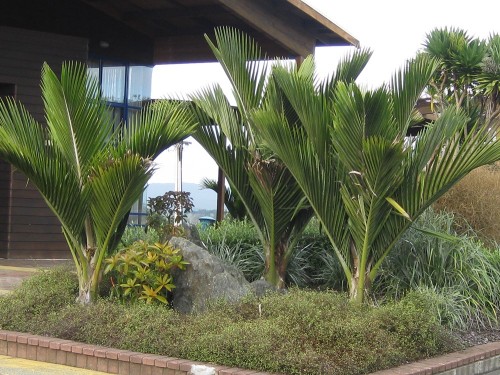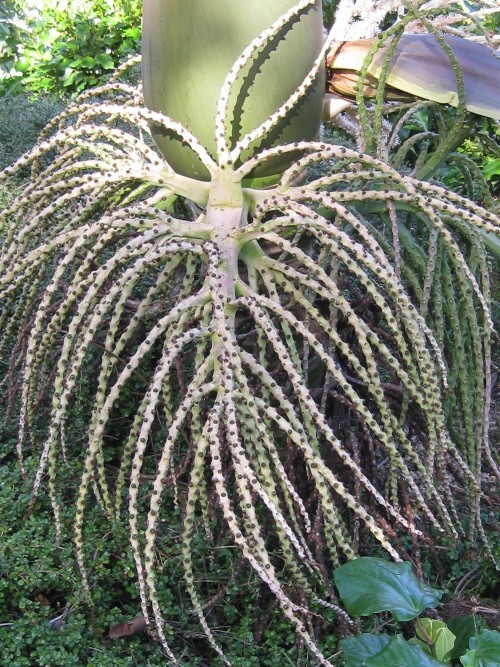Rhopalstylis
The Rhopalstylis is a genus containing just two species of palm including the most southerly palm the Chatham Island Nikau and the other confined to Norfolk Island with a variety on the Kermadec Islands.
Found mostly in coastal lowland and hilly forests throughout the north island except the central plateau. In the south island as far south as Wanganui Bluff on the west coast, banks peninsula on the east and also Chatham Island. A medium sized palm will grow to nine metres tall with a trunk up to 23cm in diameter, fronds at 1.5m – 4m in length, flowering can be quite attractive with large spiky inflorescences containing pinkish purple flowers which hang down below the base of the leaves, flowers are flowered by bright red fruit which make excellent bird food. The central bud is edible and was eaten by both early Maori and Europeans.

Nikau palms are becoming increasingly popular as landscaping specimens. Take for example the recent plantings in and around Queen Street in central Auckland. These fabulous plantings will only further enhance these plants popularity. Nikau are already extremely popular overseas particularly on the western seaboard of the United States where they arrived over one hundred and fifty years ago with the shipments of our Kauri timber. There they are commonly known as the ""feather duster palms or the "shaving brush palms".
First class selection of the right varieties will be the key to this plant's continuing popularity. During a visit to our nursery by perhaps NZ's foremost expert and author on native plants Lawrie Metcalf, he described the Nikau growing in our area as perhaps the most pathetic specimens in the country. Nurseryman, landscapers and the home gardener need to select good forms which are robust, do not get tatty in the wind and grow as fast as possible.
It would appear that it is the off shore islands of the Kermadec, Great Barrier, and the Chatham's which offer forms with the most potential for the landscape gardens.
At Tawapou these are the only three varieties of Nikau that we grow.
The Kermadec Islands Nikau (Rhopalostylis baueri var. cheesemanii).
This palm as its common name suggests is found only on Raoul Island in the Kermadec group. It is a far more tropical looking palm compared to the NZ Nikau having larger, wider fronds and slightly lime green in colour and much larger more open flower heads. Although it will tolerate growing in the shade it will grow much better when it can head to full sunlight.
We have a great comparison in our nursery garden of two of these palms planted at the same time, one in the sun and one in shade. The plant in the sun has a fully formed trunk over a metre high and has been flowering for a number of years, whereas the palm in the shade has not yet produced a trunk nor has it flowered. They are best planted in rich fertile soil, in a sheltered north facing location.

Great Barrier Island Nikau (Rhopalstylis sapida).
This Nikau has that classic iconic NZ look with distinctive upright stiff fronds and the American term "shaving brush" or "feather duster" palm is a very appropriate description for the form of this Nikau.
To obtain the best effects it should be planted in a rich fertile soil, in a warm reasonably sheltered position, feet in the shade head in the sun.
Chatham Island Nikau (Rhopalstylis sapida).
The Chatham island Nikau differs from the main land species by having broader leaves and leaflets which start much further up the midrib of each frond leaving them quite bare at the base, this makes it quite distinctive, and as you would expect this Nikau would appear to be the most tolerant of exposed situations and has huge potential to retain its neatness in gardens and cities throughout NZ.
We propagate all our palms by seeds and are careful to select the correct varieties. Nikau's give any NZ garden a distinctive tropical flavor they can also be grown in large containers for a number of years.
